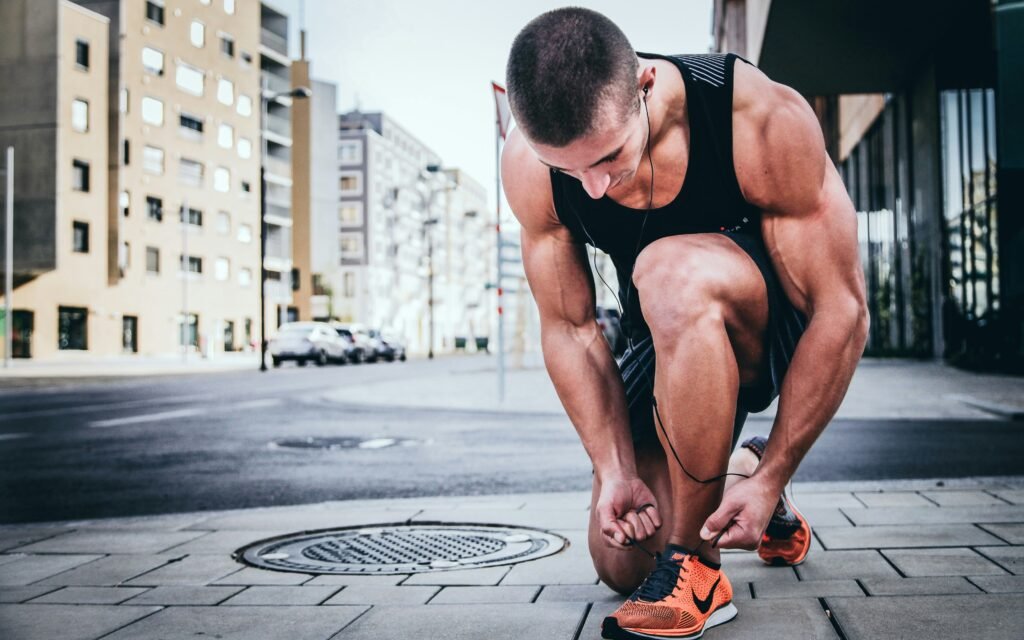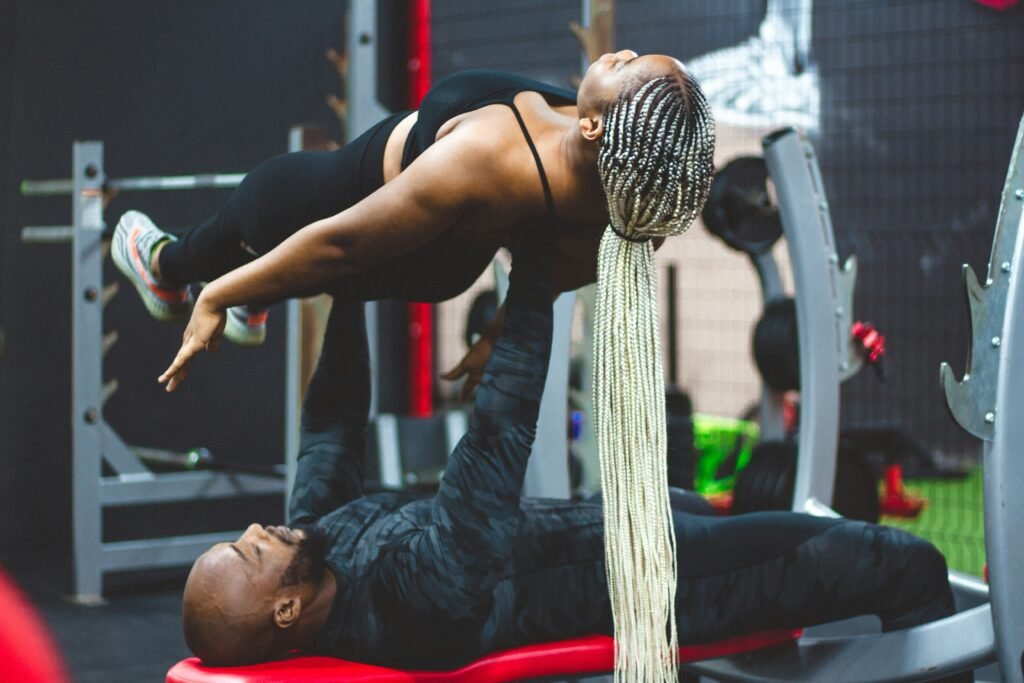
Are you looking to maximize your workout potential without breaking the bank? Look no further – building a home gym with used equipment may be the answer you’ve been searching for. Don’t underestimate the power of second-hand gym gear – it can provide immense value and help you achieve your fitness goals. In this article, we will explore why using used gym equipment can be a smart choice, the benefits it offers, and how you can make the most out of your workouts from the comfort of your own home. Get ready to transform your workout routine and elevate your fitness game with minimal investment.

This image is property of images.unsplash.com.
Benefits of Using Used Gym Equipment
Cost-effective option
Investing in used gym equipment can be a cost-effective choice for fitness enthusiasts. Compared to purchasing brand-new equipment, buying used can save you a significant amount of money. Whether you’re setting up a home gym or upgrading your commercial facility, opting for used equipment allows you to get more bang for your buck.
Variety of options
When you choose to buy used gym equipment, you open yourself up to a wide range of options. From cardio machines like treadmills and ellipticals to strength training equipment like weight benches and cable machines, there’s a vast selection available in the used market. This variety enables you to customize your workout space according to your specific fitness goals and preferences.
Quality equipment
Contrary to common misconceptions, used gym equipment can still offer excellent quality and functionality. Many reputable sellers refurbish their used equipment, ensuring that it is in good working condition and ready for use. Additionally, you can find brands and models that are no longer in production, allowing you to access high-quality equipment that may be hard to find otherwise.
Sustainable choice
Opting for used gym equipment is also an environmentally sustainable choice. By purchasing pre-owned equipment, you are extending its lifespan and reducing the demand for new manufacturing. This contributes to the preservation of natural resources and helps minimize the environmental impact associated with the production and disposal of gym equipment.
How to Choose the Right Used Gym Equipment
Assess your fitness goals
Before you start shopping for used gym equipment, it’s important to assess your fitness goals. Determine what types of exercises or workouts you want to focus on and prioritize the equipment that will help you achieve those goals. Whether you’re looking to improve cardiovascular health, build strength, or enhance flexibility, understanding your fitness objectives will guide your equipment choices.
Consider the space available
Take into account the available space in your home or facility when selecting used gym equipment. Measure the dimensions of the area where you plan to set up your gym and ensure that the equipment you choose can fit comfortably. Consider the layout and arrangement of the equipment to optimize the space and create an efficient and functional workout area.
Research reputable sellers
To ensure a positive purchasing experience, it’s essential to research and buy from reputable sellers. Look for sellers with a proven track record of customer satisfaction and positive reviews. Check if they refurbish the equipment and provide warranties to guarantee its quality and functionality. By doing thorough research, you can minimize the risk of buying subpar or faulty equipment.
Inspect the equipment
Before finalizing your purchase, thoroughly inspect the used gym equipment. Check for any signs of wear and tear, such as rust, cracks, or fraying cables. Ensure that all parts and components are intact and in good working condition. Pay attention to the overall cleanliness and maintenance of the equipment as well. If you have any concerns or questions, don’t hesitate to ask the seller for more information.
Test functionality
To ensure the equipment is in proper working order, test its functionality before making a purchase. Try out different settings and resistance levels to check if they function as expected. For cardio machines, test the various programs and monitor functions. For strength training equipment, test the range of motion and resistance mechanisms. This step is crucial in avoiding any surprises or disappointments after the equipment is brought home.
Check for warranty
Verify if the used gym equipment comes with any warranty or guarantee. Some sellers offer warranties on their refurbished equipment, providing you with added peace of mind. Having a warranty ensures that you can address any issues or malfunctions that may arise and have the equipment repaired or replaced within a specified period. It’s always beneficial to have that extra layer of protection for your investment.

This image is property of images.unsplash.com.
Popular Types of Used Gym Equipment
Cardio machines
Cardio machines are essential for improving cardiovascular fitness and burning calories. Common types of used cardio equipment include treadmills, stationary bikes, ellipticals, stair climbers, and rowing machines. These machines offer a low-impact workout option that can be customized to your desired intensity and duration.
Strength training equipment
Strength training equipment helps build and tone muscles, increase bone density, and improve overall strength and endurance. Used strength training equipment includes weight benches, barbells, dumbbells, resistance machines, and cable systems. By incorporating strength training into your workout routine, you can achieve a well-rounded fitness regimen.
Free weights
Free weights, such as dumbbells, kettlebells, and weight plates, are versatile and effective tools for strength training. They allow for a wide range of exercises that target specific muscle groups and provide functional movements. Used free weights are a cost-effective option for those looking to add resistance training to their home gym.
Functional training gear
Functional training gear includes equipment like stability balls, medicine balls, resistance bands, and suspension trainers. These tools are designed to improve stability, flexibility, balance, and core strength. Used functional training gear can be an affordable way to enhance your workout routine and incorporate functional movements into your exercises.
Yoga and Pilates accessories
For those who enjoy yoga or Pilates, used accessories such as yoga mats, blocks, straps, and Pilates reformer machines can be valuable additions to your home gym. These accessories provide support, enhance flexibility, and aid in proper alignment during yoga and Pilates sessions.
Rehabilitation and mobility aids
Used gym equipment also includes rehabilitation and mobility aids like foam rollers, massage balls, balance boards, and resistance bands. These aids are helpful for post-workout recovery, injury prevention, and improving flexibility and mobility. Incorporating these tools into your fitness routine can help you stay injury-free and maintain optimal physical function.
Setting Up Your Home Gym
Designate a dedicated space
When setting up a home gym, it’s important to designate a dedicated space solely for fitness activities. This space could be a spare room, a corner of a basement, or even a garage. Having a designated area can help create a focused and motivating environment that is separate from the distractions of everyday life.
Arrange equipment strategically
To optimize the functionality and flow of your home gym, arrange the equipment strategically. Consider the layout and accessibility of each piece of equipment. Place frequently used items within easy reach and ensure there is enough space for movement and proper form during exercises. Keep in mind the space limitations you identified earlier and plan accordingly.
Ensure proper ventilation and lighting
A well-ventilated and well-lit space is essential for an enjoyable and effective workout. Ensure that your home gym area has proper airflow to prevent stuffiness and optimize comfort. Additionally, proper lighting is important for both safety and motivation. Natural light is preferred, but if that’s not possible, consider installing bright and evenly distributed artificial lighting.
Consider storage options
Having adequate storage options in your home gym is crucial for keeping the space organized and safe. Invest in storage solutions such as shelves, cabinets, or racks to store smaller accessories like resistance bands, dumbbells, and yoga mats. Keeping the area clutter-free will not only maintain a visually appealing space but also reduce the risk of accidents or injuries caused by tripping over equipment.
Create a motivating environment
Your home gym should be a space that inspires and motivates you to stay committed to your fitness goals. Personalize the area with motivational quotes, uplifting artwork, or even a favorite playlist. Consider hanging mirrors to check your form during exercises and to create an illusion of a larger space. Making your home gym an inviting and uplifting environment can greatly enhance your workout experience.

This image is property of images.unsplash.com.
Maintaining and Caring for Used Gym Equipment
Clean equipment regularly
Regular cleaning is crucial to maintain the hygiene and functionality of your used gym equipment. Wipe down the surfaces with a mild disinfectant or cleaning solution after each use to remove sweat and bacteria. Clean the grips, handles, and touchscreens thoroughly. By keeping your equipment clean, you ensure a healthy and safe workout environment.
Check for loose components
Periodically inspect your used gym equipment for any loose components. Check for screws, bolts, or nuts that may have come loose over time. Tighten them as needed to ensure the stability and safety of the equipment. Loose components can compromise the functionality and structural integrity of the equipment, so it’s important to address this issue promptly.
Inspect cables and pulleys
For machines that use cables and pulleys, regular inspection is essential. Look out for frayed cables, worn-out pulleys, or any signs of damage. Replace any faulty or compromised parts immediately to prevent accidents and maintain the proper functionality of the equipment. Lubricate the cables and pulleys as recommended by the manufacturer to prevent friction and ensure smooth movement.
Keep equipment lubricated
Proper lubrication is important for the smooth operation of certain gym equipment components. Check the manufacturer’s instructions for guidance on lubricating pivot points, treadmill belts, or other moving parts. Regular lubrication helps reduce wear and tear and extends the lifespan of your used gym equipment.
Store equipment properly
When not in use, it’s crucial to store your used gym equipment properly. Keep it in a dry, clean, and climate-controlled environment to prevent damage from moisture, dust, or temperature fluctuations. If possible, cover the equipment to protect it from accidental spills, direct sunlight, or pets. Proper storage ensures that your equipment remains in good condition between workouts.
Schedule maintenance and repairs
To ensure the longevity and optimal performance of your used gym equipment, it’s important to schedule regular maintenance and repairs. Follow the manufacturer’s recommendations for servicing intervals or consult with a professional technician. Regular maintenance can catch minor issues before they become major problems and keep your equipment functioning at its best.
Maximizing Your Workout Potential
Focus on proper form and technique
When using used gym equipment, it’s essential to prioritize proper form and technique. Focus on performing exercises correctly and safely to maximize their effectiveness and minimize the risk of injury. If you’re unsure about proper form, consider working with a fitness professional who can guide you and provide proper instruction.
Gradually increase intensity
As with any fitness routine, gradually increasing the intensity of your workouts is important for progression. Start with lighter weights or lower resistance levels and gradually increase as your strength and endurance improve. This approach allows your body to adapt and reduces the risk of overexertion or strain.
Incorporate variety into your routine
To prevent boredom and keep your workouts challenging, incorporate variety into your routine. Mix up your exercises, equipment, and training methods to target different muscle groups and engage your body and mind. Try new workouts, participate in group classes, or explore online fitness platforms for fresh ideas and motivation.
Set specific goals
Setting specific goals can help you stay focused and motivated when using used gym equipment. Whether it’s achieving a certain weightlifting target, running a specific distance, or improving flexibility, having clear objectives gives you something to work towards. Write down your goals and track your progress to stay accountable and celebrate your achievements.
Track your progress
Monitoring your progress is essential for tracking your fitness journey and evaluating the effectiveness of your workout routine. Keep a journal or use fitness tracking apps to record your workouts, sets, and repetitions. Note any improvements or changes in your strength, endurance, or body composition. This data can help you adjust your routine and set new goals.
Listen to your body
When using used gym equipment, it’s important to listen to your body’s signals. Pay attention to any pain, discomfort, or unusual sensations during workouts. If something doesn’t feel right, modify or stop the exercise. Pushing through pain or disregarding warning signs can lead to injuries and setbacks. Prioritize your safety and well-being.
Consider professional guidance
If you’re new to using used gym equipment or have specific fitness goals, consider seeking professional guidance. Hiring a personal trainer or working with a fitness coach can provide you with expert advice, personalized workout plans, and proper instruction. They can help you make the most of your equipment and ensure you’re on the right track to achieving your fitness goals.
Tips for Buying Used Gym Equipment
Do thorough research
Before purchasing used gym equipment, invest time in doing thorough research. Compare prices, models, and features across different sellers or platforms. Read online reviews and testimonials to gather insights from other buyers. Having a good understanding of the market and available options will enable you to make an informed decision.
Check seller reviews and ratings
When buying used gym equipment, it’s important to check the reviews and ratings of the seller. Look for reputable sellers with positive feedback and high ratings. Pay attention to the overall satisfaction of previous customers and any comments on the quality, condition, or buying experience. This information can help you determine the trustworthiness of the seller.
Ask about the equipment’s history
Request information about the history of the used gym equipment you’re interested in. Inquire about the age of the equipment, how often it was used, and if any repairs or refurbishments have been done. Knowing the equipment’s history can give you an idea of its durability, potential issues, and maintenance requirements.
Ensure safety features are intact
Inspect the used gym equipment to ensure that all safety features are intact. Check for safety locks, emergency stop buttons, and adjustable settings. Safety features are crucial for preventing accidents and injuries during workouts. Do not compromise on safety when purchasing used equipment.
Negotiate the price
When buying used gym equipment, don’t be afraid to negotiate the price. Sellers may be willing to offer a lower price or include additional accessories as part of the deal. However, be reasonable in your negotiations and ensure that the price reflects the condition and quality of the equipment. Don’t compromise on quality to save a few dollars.
Clarify return and warranty policies
Before making a purchase, clarify the seller’s return and warranty policies. Understand the conditions under which you can return or exchange the equipment if necessary. Additionally, inquire about any warranty or guarantee that comes with the used equipment. Having this information will give you peace of mind and protect your investment.
Safety Precautions When Using Used Gym Equipment
Warm up before each session
Before using any used gym equipment, it’s essential to warm up your muscles and elevate your heart rate. Engage in dynamic stretching, light cardio exercises, or foam rolling. Warming up properly helps prepare your body for the workout, increases blood flow to the muscles, and reduces the risk of strains or injuries.
Use proper safety gear
Wearing proper safety gear is crucial when using used gym equipment. Depending on the exercises you’re performing, consider wearing appropriate shoes, lifting belts, gloves, or knee pads. Safety gear protects your body from impact, provides support, and ensures a safer workout experience.
Start with lighter weights
If you’re new to strength training or unfamiliar with the used equipment you’re using, start with lighter weights. Begin with a weight that allows you to perform exercises with proper form and technique. Gradually increase the weight as you become comfortable and confident in your movements.
Listen to your body’s signals
Pay attention to your body’s signals during workouts. If you experience pain, extreme fatigue, dizziness, or shortness of breath, take a break and seek medical attention if necessary. Pushing through discomfort or ignoring warning signs can lead to serious injuries or health complications.
Avoid overexertion
When using used gym equipment, it’s important to avoid overexertion. Gradually increase the intensity and duration of your workouts over time. Pushing beyond your limits can lead to overtraining, fatigue, and increased risk of injury. Listen to your body and adjust your workouts accordingly.
Stay hydrated
Proper hydration is crucial when engaging in physical activity. Drink water before, during, and after your workouts to maintain optimal hydration levels. Dehydration can negatively impact your performance, muscle function, and overall well-being. Keep a water bottle nearby and take regular sips throughout your workout.
Seek medical clearance if necessary
If you have any pre-existing medical conditions or concerns, it’s important to seek medical clearance before using used gym equipment. Consult with your healthcare provider to ensure that exercising with certain equipment or performing specific exercises is safe for you. They can provide valuable guidance and recommendations based on your individual health circumstances.
Common Mistakes to Avoid
Buying equipment without a plan
One common mistake to avoid is purchasing used gym equipment without a plan. Before you start shopping, identify your specific fitness goals, the types of exercises or workouts you enjoy, and the equipment that will help you achieve those goals. Having a plan will prevent you from making impulsive purchases that may not align with your needs or preferences.
Neglecting proper maintenance
Another mistake to avoid is neglecting proper maintenance of your used gym equipment. Regular cleaning, inspection, lubrication, and repair are essential for the longevity and functionality of the equipment. Set reminders or create a maintenance schedule to ensure that you stay on top of these tasks and keep your equipment in optimal condition.
Ignoring warning signs of equipment wear
Ignoring warning signs of equipment wear is a mistake that can lead to accidents or equipment failure. Be vigilant and address any signs of wear and tear, loose components, or malfunctioning parts as soon as they are noticed. Prompt action can prevent further damage and maintain the safety and effectiveness of your used gym equipment.
Not seeking professional advice when needed
If you’re unsure about proper form, technique, or how to use specific used gym equipment, it’s important to seek professional advice. Neglecting to do so can lead to ineffective workouts, lack of progress, or even injuries. Consider working with a personal trainer, fitness coach, or attending instructional classes to ensure that you’re using the equipment correctly and safely.
Skipping warm-up and cooldown
Skipping the warm-up and cooldown portions of your workout is a common mistake that can increase the risk of injuries and hinder overall progress. Warm-up exercises prepare your body for the workout ahead, while cooldown exercises help you gradually return to a resting state and facilitate recovery. Dedicate time to both warm-up and cooldown routines for a well-rounded and safe workout experience.
Overlooking safety precautions
Safety should always be a top priority when using used gym equipment. Overlooking safety precautions, such as improper use of equipment, lack of proper form, or failing to use safety features, can result in accidents and injuries. Take the time to familiarize yourself with the equipment, follow safety guidelines, and prioritize your well-being throughout your workout sessions.
Final Thoughts
Used gym equipment can be a smart investment for fitness enthusiasts who want to maximize their workout potential while staying within budget. By choosing used equipment, you can enjoy the benefits of cost savings, a variety of options, and quality equipment. Remember to assess your fitness goals, consider the available space, research reputable sellers, inspect the equipment, and test its functionality before making a purchase.
When setting up your home gym with used equipment, designate a dedicated space, arrange the equipment strategically, ensure proper ventilation and lighting, consider storage options, and create a motivating environment. By following proper maintenance and caring for your used gym equipment, you can prolong its lifespan and ensure optimal functionality.
To achieve your fitness goals, focus on proper form and technique, gradually increase intensity, incorporate variety into your routine, set specific goals, track your progress, listen to your body, and consider professional guidance when needed. When buying used gym equipment, do thorough research, check seller reviews and ratings, ask about the equipment’s history, ensure safety features are intact, negotiate the price, and clarify return and warranty policies.
Lastly, prioritize safety throughout your workouts by warming up, using proper safety gear, starting with lighter weights, listening to your body’s signals, avoiding overexertion, staying hydrated, and seeking medical clearance if necessary. By avoiding common mistakes such as buying equipment without a plan, neglecting maintenance, ignoring warning signs, and skipping safety precautions, you can make the most of your used gym equipment and enjoy a safe and effective workout experience.


